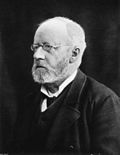diphtheria, which was called Klebs–Loeffler bacterium (now Corynebacterium diphtheriae). He was the father of physician Arnold Klebs. Klebs was born in Königsberg...
12 KB (1,226 words) - 13:55, 27 February 2024
Corynebacterium diphtheriae (redirect from Klebs-Loeffler bacillus)
diphtheria. It is also known as the Klebs–Löffler bacillus because it was discovered in 1884 by German bacteriologists Edwin Klebs (1834–1912) and Friedrich Löffler...
23 KB (2,656 words) - 00:15, 23 August 2024
Klebsiella pneumoniae (redirect from Klebs pneumo)
3-hydroxybutyrate. The genus Klebsiella was named after the German microbiologist Edwin Klebs (1834–1913).[citation needed] It is also known as Friedlander's bacillum...
42 KB (4,195 words) - 12:11, 8 May 2024
Klebs is a German surname. Notable people with the surname include: Arnold Klebs (1870–1943), Swiss microbiologist and physician; son of Edwin Klebs Edwin...
749 bytes (135 words) - 07:33, 4 December 2020
polysaccharide-based capsule. Klebsiella is named after German-Swiss microbiologist Edwin Klebs (1834–1913). Carl Friedlander described Klebsiella bacillus which is...
17 KB (1,718 words) - 14:23, 7 July 2024
1883, Edwin Klebs identified the bacterium causing diphtheria, and named it Klebs–Loeffler bacterium. The club shape of this bacterium helped Edwin to differentiate...
55 KB (5,621 words) - 10:29, 17 September 2024
"Pseudohermaphroditimus" (pseudohermaphroditism) was coined in German by Edwin Klebs in 1876. Klebs had included the term as a synonym for the earlier coined, "spurious...
15 KB (1,439 words) - 21:41, 12 September 2024
In the same year, Canada balsam appeared on the scene, and in 1869 Edwin Klebs (1834-1913) reported that he had for some years embedded his specimens...
33 KB (3,197 words) - 22:58, 11 September 2024
disease. In April 1880, three months prior to Eberth's publication, Edwin Klebs described short and filamentous bacilli in the Peyer's patches in typhoid...
96 KB (10,677 words) - 02:17, 28 September 2024
of medical knowledge through the Middle Ages into the 19th century. Edwin Klebs was the first to observe bacteria in the airways of persons having died...
120 KB (12,708 words) - 05:09, 18 September 2024








